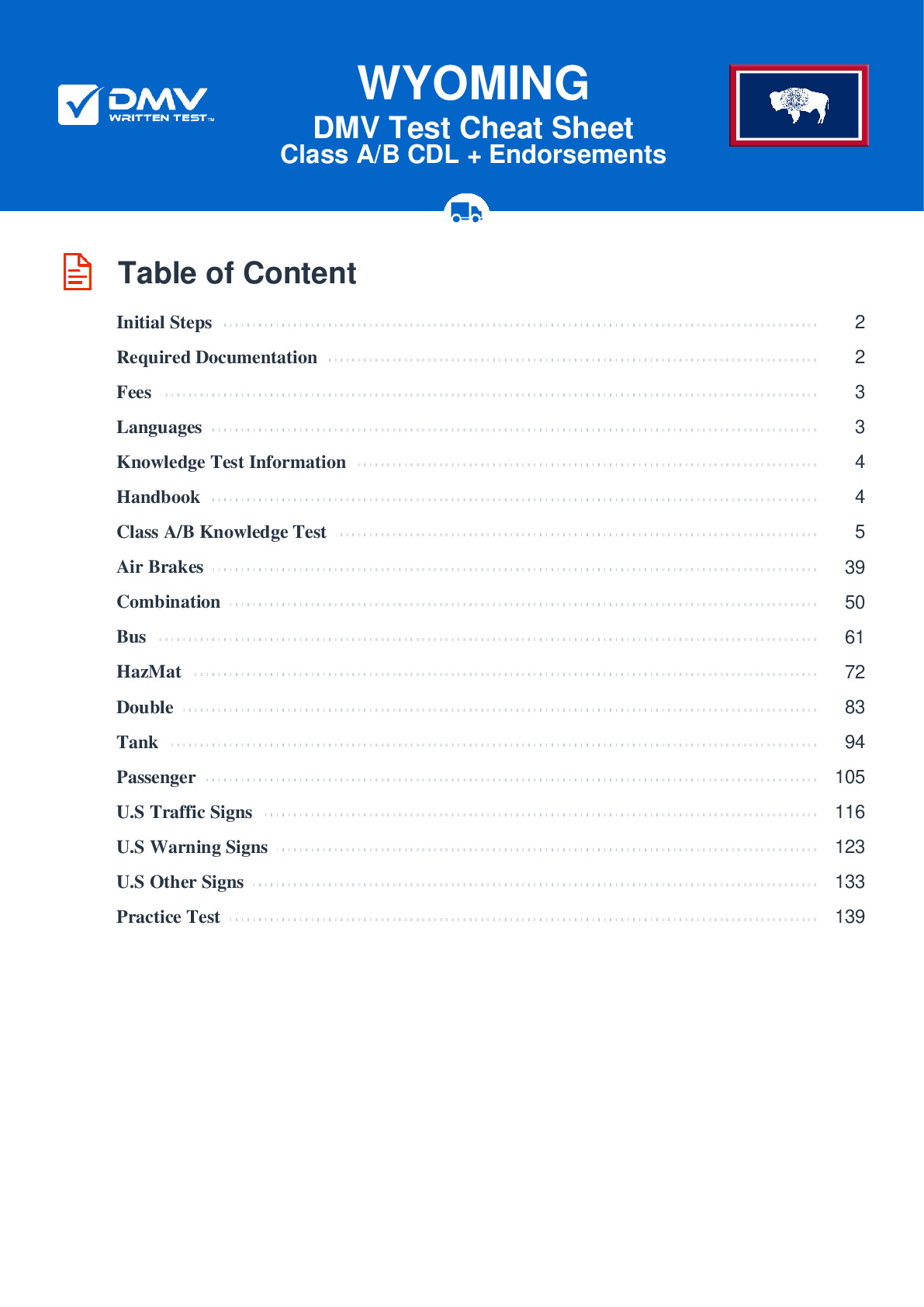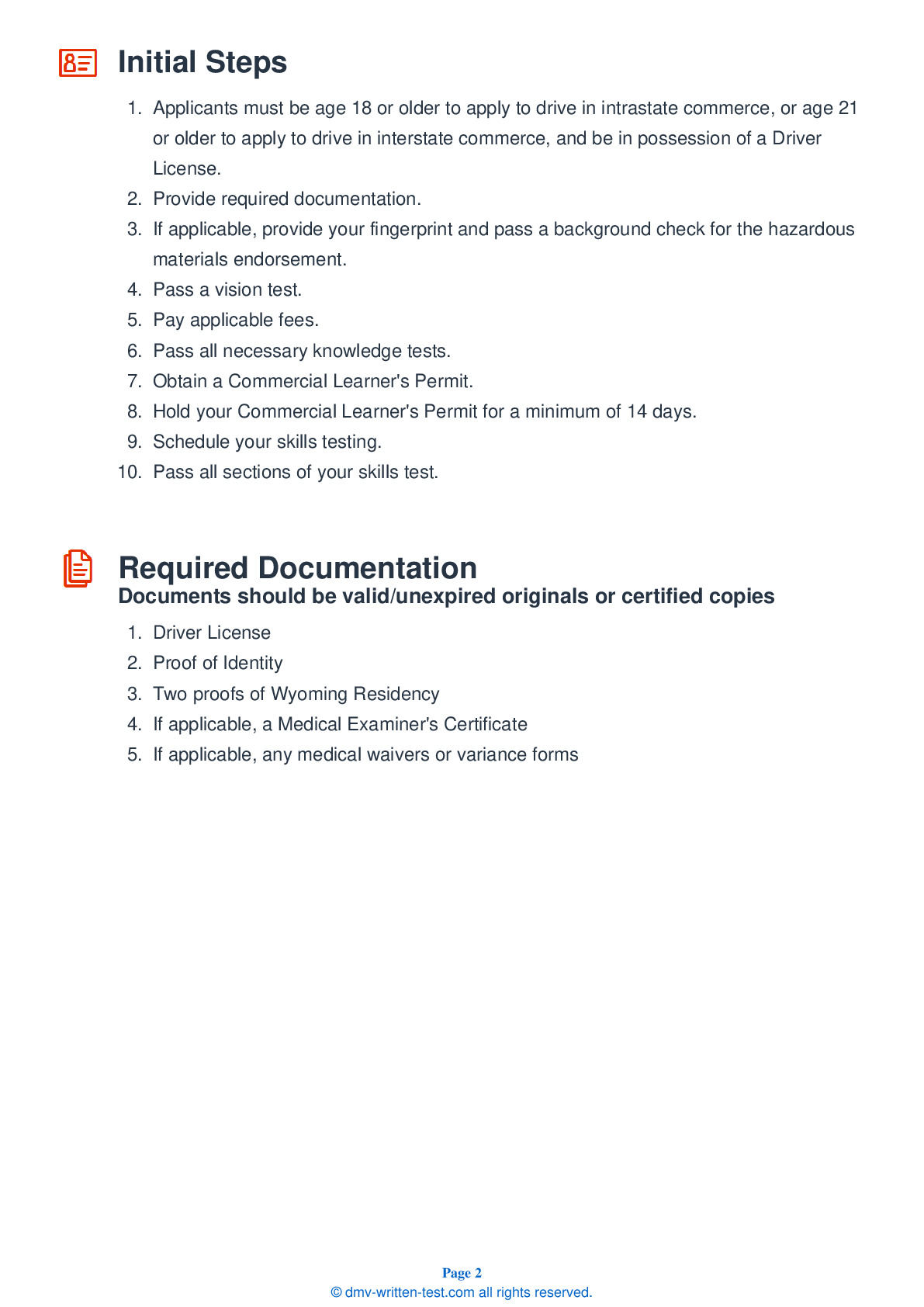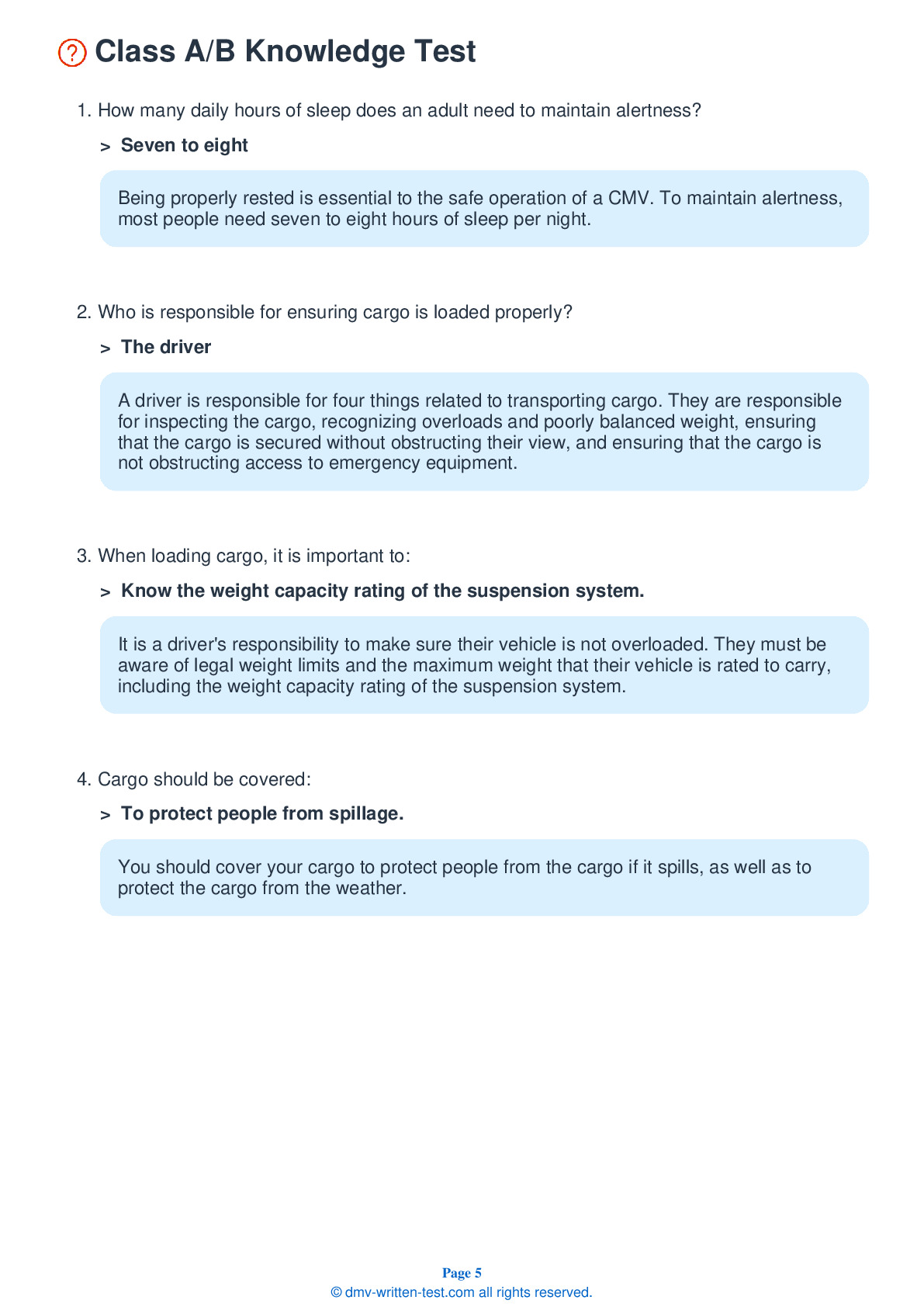Knowledge Test Class A
This license is required for driving any legal combination of vehicles, with a gross combination weight rating of 26,001 pounds or more, provided the GVWR of a trailer exceeds 10,000 pounds To receive this license, applicants must pass a 50-question test. To pass, applicants must answer 40 questions correctly. Each question has three or four possible answer choices. Test questions come from the Wyoming Driver License Manual for Commercial and Heavy Vehicles. Questions come from chapters covering: Introduction, Driving Safely, Transporting Cargo Safely, Air Brakes (if applicable), Combination, Doubles and Hazardous Materials. Endorsements that may be used with a Class A CDL are: Hazardous materials, Tank, Passenger, HazMat and Tank, Air Brakes and School bus.
36. When loading a trailer, weight should be:
Cargo with a high center of gravity makes a vehicle more likely to tip over than cargo with a low center of gravity. For this reason, it is important that the weight of cargo be distributed as low as possible.
37. To prevent your vehicle from rolling backward when beginning to move, you can:
To ensure that your vehicle does not roll backward when beginning to move after a stop, you should partly engage the clutch before removing your right foot from the brake pedal.
38. How should you test the low pressure warning signal?
It is essential that your low pressure warning light functions properly. After allowing the system to charge, you can test the warning signal by rapidly applying and releasing the brake pedal. This will release air from the braking system and the warning signal should come on when pressure drops to a dangerous level.
39. An alcohol evaporator in an air brake system:
Some air brake systems include an evaporator that introduces alcohol into the system. The alcohol can help prevent ice from forming within the system.
40. While driving, if it is discovered a vehicle's ABS is not working, the driver should:
If an Anti-Lock Braking System (ABS) is not working, the vehicle's basic braking functions are still intact. The driver should continue to drive and brake in a normal fashion.
41. In a dual air brake system:
A dual air brake system is made up of two separate air brake systems. The systems share a single set of brake controls, but each has its own air tanks, hoses, and lines.
42. Fuel records supporting IFTA quarterly fuel use tax returns must be kept by carriers for:
In general, if you operate a commercial vehicle in interstate commerce, it must be registered under the International Registration Plan (IRP) and International Fuel Tax Agreement (IFTA). These programs collect and distribute vehicle registration fees and fuel taxes based on what jurisdictions you drive in and for how long. Mileage and fuel records supporting IFTA quarterly fuel tax returns must be retained by carriers for four years.
Frequently Asked Questions
- Tractor-trailers
- Livestock carriers
- Flatbeds
- Tanker trucks
- Dump trucks with trailers
- Other heavy-duty vehicles that require a Class A CDL
It's important to note that drivers with a Class A CDL must also have any necessary endorsements for specific types of cargo or vehicles they may be transporting. For example, drivers who transport hazardous materials must have a Hazmat endorsement on their CDL.
1. Be at least 18 years old: However, you must be at least 21 years old to transport hazardous materials or operate a commercial vehicle across state lines.
2. Have a valid driver's license: You must have a valid driver's license issued by Wyoming or another state.
3. Meet medical requirements: You must pass a medical examination and be certified as physically qualified to operate a commercial motor vehicle.
4. Obtain a commercial learner's permit (CLP): Before you can take the skills test, you must first obtain your CLP and hold it for a minimum of 14 days.
5. Pass the written test: You must pass a series of written tests, including the general knowledge test and any applicable endorsement tests.
6. Pass the skills test: You must pass a skills test that includes a pre-trip inspection, basic vehicle control, and on-road driving.
7. Pay the required fees: There are fees associated with obtaining your CDL, including application fees and testing fees.
It's important to note that additional requirements may apply depending on your specific situation or the type of cargo you plan to transport.
Drivers who are at least 21 years old are eligible to obtain a Class A CDL license that allows them to operate commercial vehicles across state lines and transport hazardous materials.
1. T - Double/Triple Trailers: This endorsement allows you to tow two or three trailers at once.
2. P - Passenger: This endorsement allows you to operate a vehicle designed to carry more than 16 passengers, including the driver.
3. N - Tank Vehicles: This endorsement allows you to operate a vehicle used for the transportation of liquids or gases in bulk containers with a capacity of 1,000 gallons or more.
4. H - Hazardous Materials: This endorsement allows you to transport hazardous materials as defined by federal law.
You must pass a written test for each endorsement you wish to obtain. Additionally, there may be additional requirements for certain endorsements, such as background checks or special training.
1. Pre-trip inspection: You will be required to perform a thorough inspection of your vehicle, explaining to the examiner what you are checking and why. This includes checking the engine compartment, coupling and uncoupling procedures, and checking the trailer.
2. Basic vehicle control skills test: You will be evaluated on your ability to perform basic maneuvers with your vehicle, including straight line backing, offset backing to the left or right, and parallel parking.
3. On-road driving test: You will be evaluated on your ability to safely operate your vehicle in various traffic situations. This includes merging onto the highway, changing lanes, making turns and stops, and completing various driving maneuvers.
During all parts of the test, you will be evaluated on your ability to safely operate your vehicle and follow all traffic laws and regulations. The entire test typically takes several hours to complete.
1. Age restrictions: You must be at least 18 years old to obtain a Class A CDL license, but you can only drive within the state of Wyoming and cannot transport hazardous materials. You must be at least 21 years old to drive across state lines or transport hazardous materials.
2. Medical requirements: To obtain or renew your Class A CDL license, you must pass a Department of Transportation (DOT) medical exam and have a valid DOT medical card.
3. Endorsements: As mentioned earlier, you may need to obtain endorsements for your Class A CDL license depending on the type of cargo you want to transport.
4. Weight restrictions: Depending on the weight of your vehicle and the type of cargo you are carrying, there may be weight restrictions or limitations you need to follow.
5. Hours of Service (HOS) regulations: As a commercial driver with a Class A CDL license, you must follow HOS regulations that limit the amount of time you can drive in a day and week to prevent fatigue-related accidents.
It's important to note that these restrictions and limitations may vary depending on federal and state regulations, so it's important to stay informed and up-to-date on any changes or updates.
However, if you have difficulty reading or understanding English, you may be able to request an interpreter or a translated version of the test. You will need to contact the Wyoming Department of Transportation to make arrangements for an interpreter or translated test. Keep in mind that these accommodations may not be available for all languages and may need to be arranged in advance.
To request accommodations, you will need to contact the Wyoming Department of Transportation's Driver Services Program and provide documentation of your disability and the specific accommodations you require. They will work with you to determine what accommodations are available and appropriate for your needs.
Examples of accommodations that may be available include extended testing time, a separate testing room, a reader or scribe, or an audio version of the test. Keep in mind that accommodations may take some time to arrange, so it's important to make your request as early as possible.
If you fail the test three times, you will need to wait at least 30 days before taking it again. If you fail the test six times, you will need to wait at least 180 days before taking it again.
Each time you take the test, you will need to pay the testing fee, which is $25 as of 2021. It's important to study and prepare thoroughly for the test to increase your chances of passing on your first attempt and avoid having to retake it multiple times.




